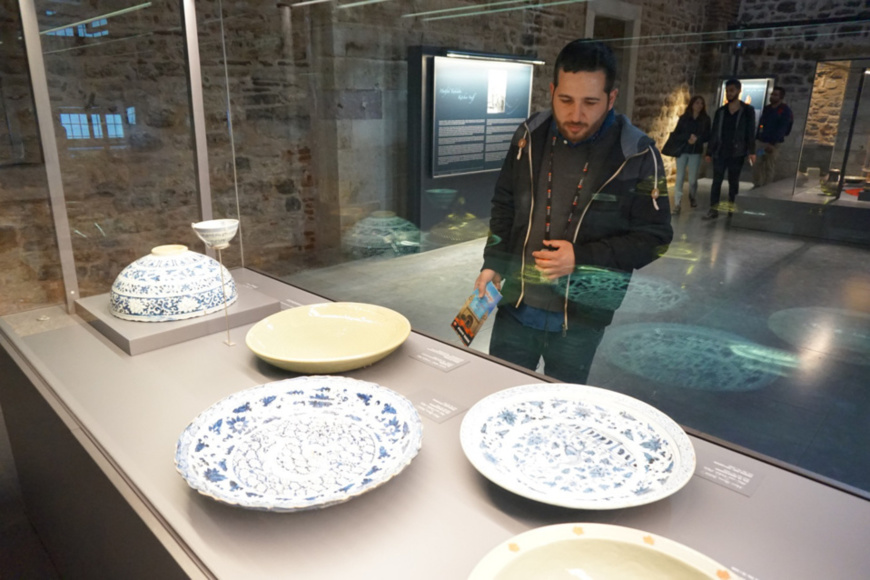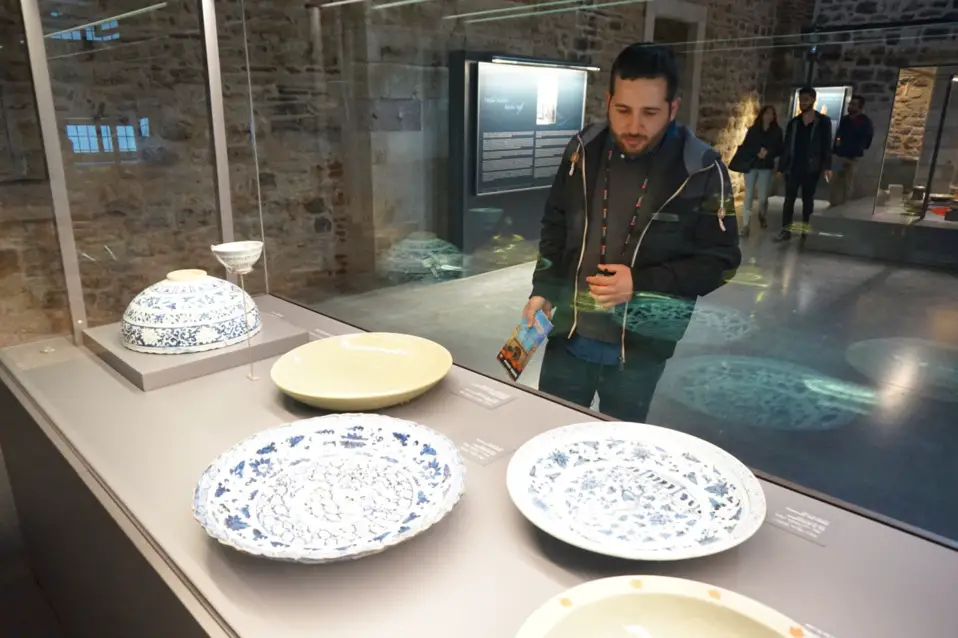Source: People’s Daily

A visitor watches the on-display porcelains introduced from China by Topkapi Palace, where a total of 10,385 Chinese porcelains tracing back to 13th century to the 20th century were collected. The ancient Silk Road has connected Istanbul, the most populous city in Turkey, with China over centuries. Those collected in the eight centuries are precious for academic studies since they reflect the historic changes of China-made porcelains. (Photo by Wang Yunsong from People’s Daily)
Turkey will render great support to the Belt and Road initiative put forward by China, its President Recep Tayyip Erdoğan pledged in a signed article, adding that his country is ready to pursue better future together with China.
The article was published on Global Times, a newspaper under People’s Daily upon the arrival of the two-day Belt and Road Forum for International Cooperation kicked off on Sunday.
The Belt and Road initiative refers to the Silk Road Economic Belt that links China with Europe through Central and Western Asia by inland routes, and the 21st Century Maritime Silk Road connecting China with Southeast Asia, Africa and Europe by sea.
The following is an abstract translation of the article written by him:
The Silk Road, over the past centuries, has been a bridge connecting the East and West world. With its unique location in the juncture of the Eurasian continent, Turkey was among the earliest en-route countries in history.
Chinese President Xi Jinping’s proposal to build the Belt and Road, coming as the Asian and European continents are deepening their trade ties in an accelerated pace, is of great significance for China-Turkey strategic cooperation.
Turkey’s Middle Corridor plan is the most important part of the blueprint to revive the ancient Silk Road. Starting from Turkey, it will reach China after passing through Georgia, Azerbaijan, Caspian Sea, Turkmenistan, Kazakhstan, Afghanistan and Pakistan.
It is proven that China’s suggestion to build the Silk Road Economic Belt can perfectly complement with Turkey’s Middle Corridor plan. We expect a closer collaboration with China in these programs since it will also point out a way for the trade in next century.
Given such backdrop, we signed a memorandum of understanding (MOU) on the harmonization of the Belt and Road with the Middle Corridor on the sidelines of the G20 Summit held in Antalya on November 14, 2015, bringing bilateral cooperation a key step forward.
As an effort to better supplement the Belt and Road development with the Middle Corridor plan, Turkey launched a series of projects including the Baku-Tbilisi-Kars railway link. After the line puts into operation in the coming months, the key component of the corridor will be concluded.
Turkey initiated an infrastructure construction spree nationwide at the same time. Yavuz Sultan Selim Bridge, the third bridge for rail and motor vehicle transit over the Bosphorus strait has been completed. The Marmaray tunnel and Eurasia Tunnel crossing the Bosphorus strait undersea have been open to traffic as well.
The Çanakkale 1915 bridge hanging on the Dardanelles Strait west of Turkey is now under construction. These roads, rail lines, logistics parks, telecommunication equipment are all part of the Middle Corridor plan.
As a saying goes, “All the flowers are gown up from the seeds we sow today”. The seeds our two governments are sowing now will lay a foundation for our later generations. Our new cooperation will generate more and more fruits from now on to 2021, when we celebrate the 50th anniversary of the establishment of diplomatic ties.
The article was published on Global Times, a newspaper under People’s Daily upon the arrival of the two-day Belt and Road Forum for International Cooperation kicked off on Sunday.
The Belt and Road initiative refers to the Silk Road Economic Belt that links China with Europe through Central and Western Asia by inland routes, and the 21st Century Maritime Silk Road connecting China with Southeast Asia, Africa and Europe by sea.
The following is an abstract translation of the article written by him:
The Silk Road, over the past centuries, has been a bridge connecting the East and West world. With its unique location in the juncture of the Eurasian continent, Turkey was among the earliest en-route countries in history.
Chinese President Xi Jinping’s proposal to build the Belt and Road, coming as the Asian and European continents are deepening their trade ties in an accelerated pace, is of great significance for China-Turkey strategic cooperation.
Turkey’s Middle Corridor plan is the most important part of the blueprint to revive the ancient Silk Road. Starting from Turkey, it will reach China after passing through Georgia, Azerbaijan, Caspian Sea, Turkmenistan, Kazakhstan, Afghanistan and Pakistan.
It is proven that China’s suggestion to build the Silk Road Economic Belt can perfectly complement with Turkey’s Middle Corridor plan. We expect a closer collaboration with China in these programs since it will also point out a way for the trade in next century.
Given such backdrop, we signed a memorandum of understanding (MOU) on the harmonization of the Belt and Road with the Middle Corridor on the sidelines of the G20 Summit held in Antalya on November 14, 2015, bringing bilateral cooperation a key step forward.
As an effort to better supplement the Belt and Road development with the Middle Corridor plan, Turkey launched a series of projects including the Baku-Tbilisi-Kars railway link. After the line puts into operation in the coming months, the key component of the corridor will be concluded.
Turkey initiated an infrastructure construction spree nationwide at the same time. Yavuz Sultan Selim Bridge, the third bridge for rail and motor vehicle transit over the Bosphorus strait has been completed. The Marmaray tunnel and Eurasia Tunnel crossing the Bosphorus strait undersea have been open to traffic as well.
The Çanakkale 1915 bridge hanging on the Dardanelles Strait west of Turkey is now under construction. These roads, rail lines, logistics parks, telecommunication equipment are all part of the Middle Corridor plan.
As a saying goes, “All the flowers are gown up from the seeds we sow today”. The seeds our two governments are sowing now will lay a foundation for our later generations. Our new cooperation will generate more and more fruits from now on to 2021, when we celebrate the 50th anniversary of the establishment of diplomatic ties.
 Menu
Menu
 Turkey ready to pursue better future together with China: Turkish President
Turkey ready to pursue better future together with China: Turkish President
















